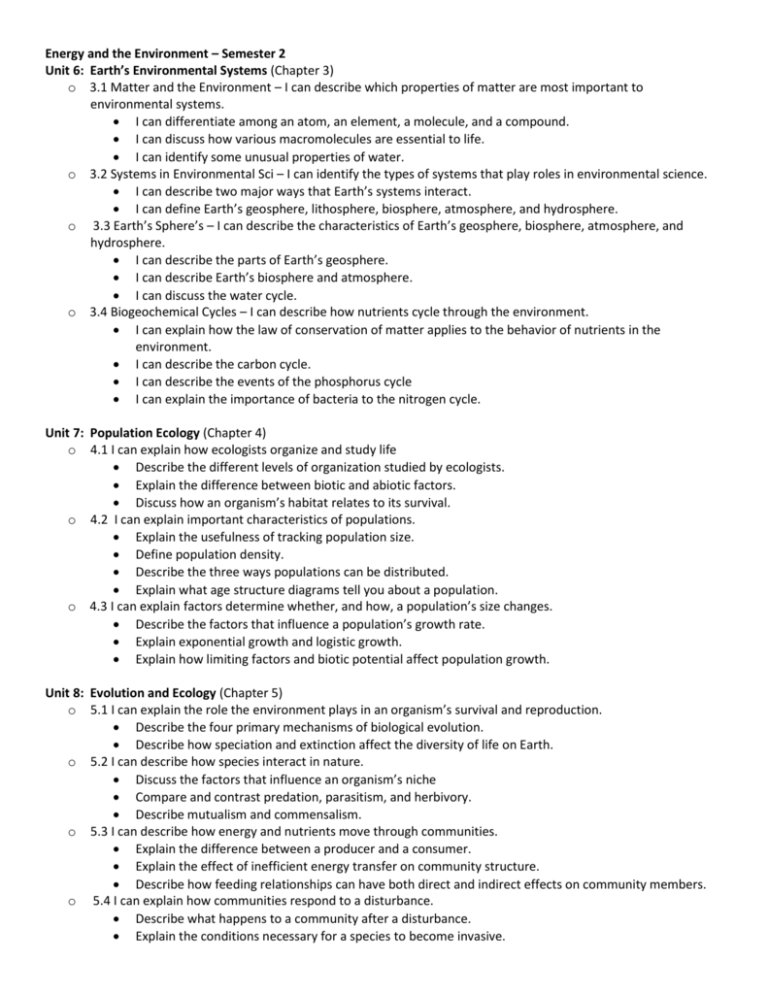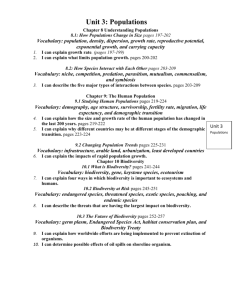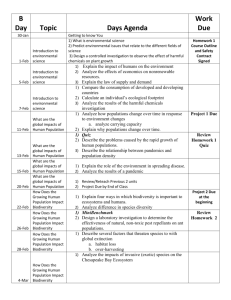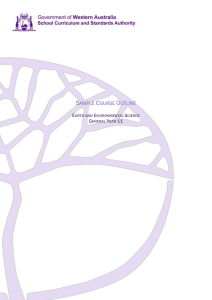Sem2 Learning Goals - Mayfield City School District
advertisement

Energy and the Environment – Semester 2 Unit 6: Earth’s Environmental Systems (Chapter 3) o 3.1 Matter and the Environment – I can describe which properties of matter are most important to environmental systems. I can differentiate among an atom, an element, a molecule, and a compound. I can discuss how various macromolecules are essential to life. I can identify some unusual properties of water. o 3.2 Systems in Environmental Sci – I can identify the types of systems that play roles in environmental science. I can describe two major ways that Earth’s systems interact. I can define Earth’s geosphere, lithosphere, biosphere, atmosphere, and hydrosphere. o 3.3 Earth’s Sphere’s – I can describe the characteristics of Earth’s geosphere, biosphere, atmosphere, and hydrosphere. I can describe the parts of Earth’s geosphere. I can describe Earth’s biosphere and atmosphere. I can discuss the water cycle. o 3.4 Biogeochemical Cycles – I can describe how nutrients cycle through the environment. I can explain how the law of conservation of matter applies to the behavior of nutrients in the environment. I can describe the carbon cycle. I can describe the events of the phosphorus cycle I can explain the importance of bacteria to the nitrogen cycle. Unit 7: Population Ecology (Chapter 4) o 4.1 I can explain how ecologists organize and study life Describe the different levels of organization studied by ecologists. Explain the difference between biotic and abiotic factors. Discuss how an organism’s habitat relates to its survival. o 4.2 I can explain important characteristics of populations. Explain the usefulness of tracking population size. Define population density. Describe the three ways populations can be distributed. Explain what age structure diagrams tell you about a population. o 4.3 I can explain factors determine whether, and how, a population’s size changes. Describe the factors that influence a population’s growth rate. Explain exponential growth and logistic growth. Explain how limiting factors and biotic potential affect population growth. Unit 8: Evolution and Ecology (Chapter 5) o 5.1 I can explain the role the environment plays in an organism’s survival and reproduction. Describe the four primary mechanisms of biological evolution. Describe how speciation and extinction affect the diversity of life on Earth. o 5.2 I can describe how species interact in nature. Discuss the factors that influence an organism’s niche Compare and contrast predation, parasitism, and herbivory. Describe mutualism and commensalism. o 5.3 I can describe how energy and nutrients move through communities. Explain the difference between a producer and a consumer. Explain the effect of inefficient energy transfer on community structure. Describe how feeding relationships can have both direct and indirect effects on community members. o 5.4 I can explain how communities respond to a disturbance. Describe what happens to a community after a disturbance. Explain the conditions necessary for a species to become invasive. Unit 9: Biodiversity and Conservation (Chapter 7) o 7.1 I can define biodiversity. Differentiate the components of biodiversity. Explain two ways in which biodiversity varies across groups or geography. Describe the economic benefits of biodiversity. o 7.2 I can explain why global biodiversity is decreasing. Describe how biodiversity is monitored and explain current biodiversity trends. List the major causes of biodiversity loss. o 7.3 I can explain how we can protect and preserve biodiversity. Explain legal actions nations can take to protect biodiversity Explain the goal of Species Survival Plans. Describe three strategies for managing whole ecosystems and habitats. Unit 10: Human Population (Chapter 8) o 8.1 I can explain why we study human populations. Describe how technological advances have contributed to human population growth. Explain recent trends in population growth. Identify characteristics of human populations that are studied by demographers. o 8.2 I can explain how the human population’s growth rate change in the future. Describe total fertility rates and replacement fertility. Explain how the age structure and sex ratio of a population define its potential for growth. Describe the demographic transition. Discuss social factors that affect population growth. o 8.3 I can define the factors that influence the impact a population has on its environment. Describe how humans impact their environments. Discuss the negative and positive impacts of technology. Environmental Health (Chapter 9) o 9.1 An Overview of Environmental Hazards o 9.2 Biological and Social Hazards o 9.3 Toxic substances in the Environment o 9.4 Natural Disasters Urbanization (Chapter 10) o 10.1 I can describe how we use the land we live on. o 10.2 Sprawl o 10.3 Sustainable Cities Forestry and Resource Management (Chapter 11) o 11.1 Resource Management o 11.2 Forests and their Resources o 11.3 Forest Management Soil and Agriculture (Chapter 12) o 12.1 Soil o 12.2 Soil Degradation and Conservation o 12.3 Agriculture o 12.4 Food Production Mineral Resources and Mining (Chapter 13) o 13.1 Minerals and Rocks o 13.2 Mining o 13.3 Forest Management Water Resources (Chapter 14) o 14.1 Earth: the water planet o 14.2 Uses of Fresh Water o 14.3 Water Pollution The Atmosphere (Chapter 15) o 15.1 Earth’s Atmosphere o 15.2 Pollution of the Atmosphere o 15.3 Controlling the Air Pollution Waste Management (Chapter 19) o 19.1 Municipal and Industrial Waste o 19.2 Minimizing Solid Waste o 19.3 Hazardous Waste Economics and Environmental Policy (Chapter 2) o 2.1 Economics o 2.2 US Environmental Policy o 2.3 International Environmental Policy and Approaches






